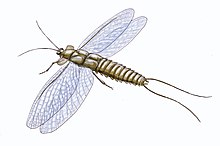Palaeodictyoptera
| Palaeodictyoptera Temporal range:
Late Permian | |
|---|---|

| |
| Reconstruction of Dunbaria fasciipennis | |
| Scientific classification | |
| Domain: | Eukaryota |
| Kingdom: | Animalia |
| Phylum: | Arthropoda |
| Class: | Insecta |
| Superorder: | †Palaeodictyopteroidea |
| Order: | †Palaeodictyoptera Goldenberg, 1877 |
| Superfamily | |
The Palaeodictyoptera are an extinct order of medium-sized to very large, primitive Palaeozoic
Overview

They were characterized by beak-like mouthparts, used to pierce plant tissues for feeding. There is a similarity between their fore- and hindwings, and an additional pair of winglets on the prothorax, in front of the first pair of wings. They are known as "six-winged insects" because of the presence of a pair of wings on each of the thoracic segments.[1][2][3][4] Their winglets provide clues to the origins of the first insect wings.
The
Some types attained huge size. For example, Mazothairos is estimated to have a wingspan of about 55 centimetres (22 in). Another distinctive feature was the presence of unusually long cerci, about twice the length of the abdomen.[5]
The Palaeodictyoptera are a
References
- .
- PMID 15703749.
- PMID 27853616.
- PMID 29374449.
- ^ ISBN 0-19-510033-6.
External links
- Paleodictyoptera at the Tree of Life project (list of taxa)
Further reading
- Carpenter, F. M. 1992. Superclass Hexapoda. Volume 3 of Part R, Arthropoda 4; Treatise on Invertebrate Paleontology, Boulder, Colorado, Geological Society of America.
- ISBN 0-521-82149-5.
- ISBN 1-4020-0026-X.
